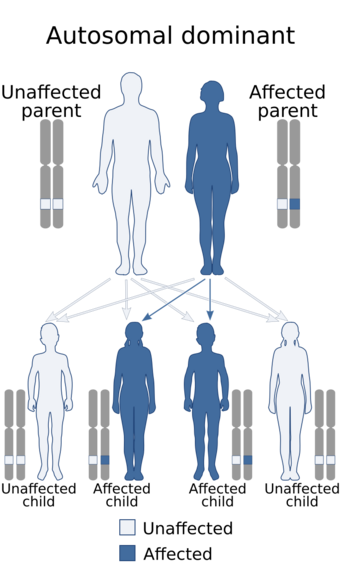Medicine:Thickened earlobes-conductive deafness syndrome
From HandWiki
| Thickened earlobes-conductive deafness syndrome | |
|---|---|
| Other names | Escher-Hirt syndrome, Schweitzer Kemink Graham syndrome |
 | |
| Specialty | Medical genetics |
| Symptoms | Ear, auditory, and jaw anomalies |
| Complications | Hearing loss |
| Usual onset | Early infancy, but whether or not the symptoms will show up is congenital |
| Duration | Life-long |
| Prevention | none |
| Prognosis | Ok |
| Frequency | very rare, only 2 families worldwide are known to have the disorder |
| Deaths | - |
Thickened earlobes-conductive deafness syndrome, also known as Escher-Hirt syndrome, or Schweitzer Kemink Graham syndrome,[1] is a rare genetic disorder which is characterized by ear and jaw abnormalities associated with progressive hearing loss.[2] Two families worldwide have been described with the disorder.[3]
Presentation
People with the disorder often have the following symptoms:[4]
Ear/Auditory
- Microtia (abnormally small ears)
- Thick earlobes
- Conductive hearing loss
- Congenital auditory ossicle anomalies
Jaw
- Micrognathia
Etiology
Escher et al. described a family with dominantly inherited conductive deafness caused by ear anomalies in 1968[5] and Wilmot et al. described another family with the same symptoms and mode of inheritance in 1970,[6] Schweitzer et al described the symptoms and declared a novel syndrome in 1984.[7]
References
- ↑ "Thickened earlobes-conductive deafness syndrome - About the Disease - Genetic and Rare Diseases Information Center" (in en). https://rarediseases.info.nih.gov/diseases/2034/thickened-earlobes-conductive-deafness-syndrome.
- ↑ RESERVED, INSERM US14-- ALL RIGHTS. "Orphanet: Thickened earlobes conductive deafness syndrome" (in en). https://www.orpha.net/consor/cgi-bin/OC_Exp.php?lng=EN&Expert=2405.
- ↑ "OMIM Entry - % 128980 - EARLOBES, THICKENED, WITH CONDUCTIVE DEAFNESS FROM INCUDOSTAPEDIAL ABNORMALITIES" (in en-us). https://omim.org/entry/128980#1.
- ↑ "Thickened earlobes-conductive deafness syndrome (Concept Id: C1851896) - MedGen - NCBI" (in en). https://www.ncbi.nlm.nih.gov/medgen/343676.
- ↑ Escher, F.; Hirt, H. (January 1968). "Dominant hereditary conductive deafness through lack of incus-stapes junction". Acta Oto-Laryngologica 65 (1): 25–32. doi:10.3109/00016486809120938. ISSN 0001-6489. PMID 5657116. https://pubmed.ncbi.nlm.nih.gov/5657116/.
- ↑ Wilmot, T. J. (1970). "Hereditary conductive deafness due to incus-stapes abnormalities and associated with pinna deformity". The Journal of Laryngology and Otology 84 (5): 469–479. doi:10.1017/s0022215100072121. ISSN 0022-2151. PMID 5428055. https://pubmed.ncbi.nlm.nih.gov/5428055/.
- ↑ Schweitzer, V. G.; Kemink, J. L.; Graham, M. D. (1984). "Conductive hearing loss, middle ear ossicular anomalies, malformed thickened lop auricles, and micrognathia. A rare autosomal dominant congenital syndrome". The American Journal of Otology 5 (5): 387–391. ISSN 0192-9763. PMID 6476090. https://pubmed.ncbi.nlm.nih.gov/6476090/.
 |

